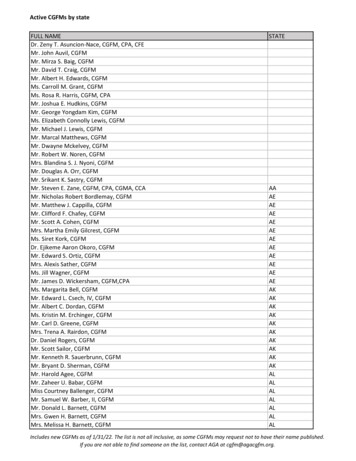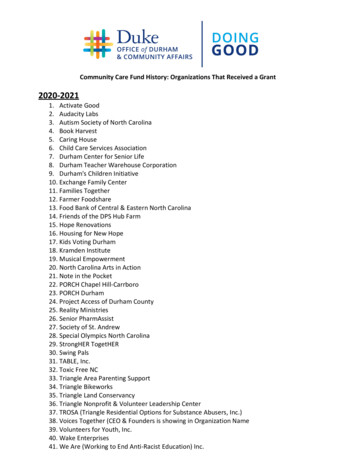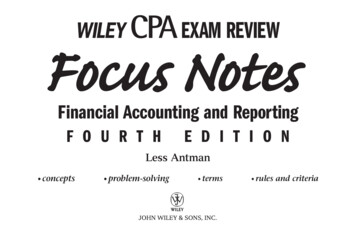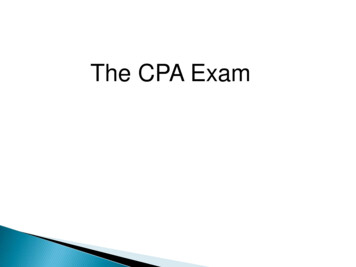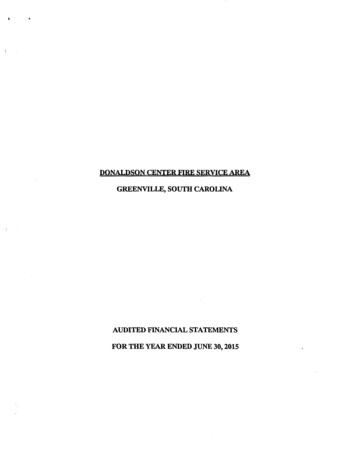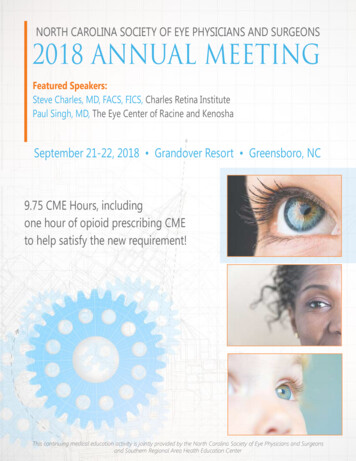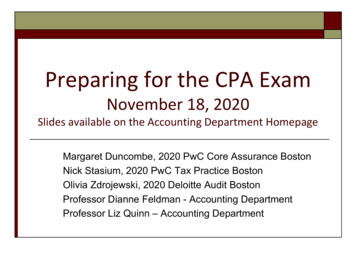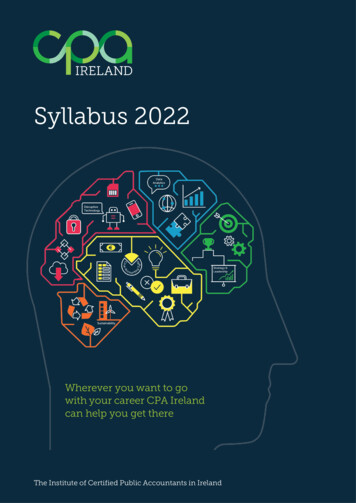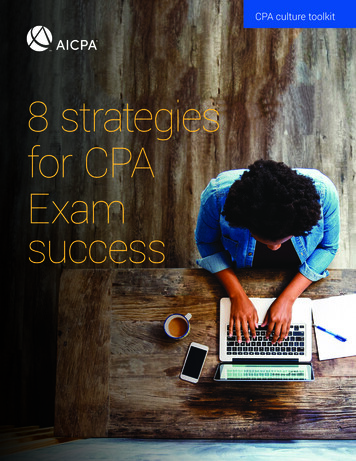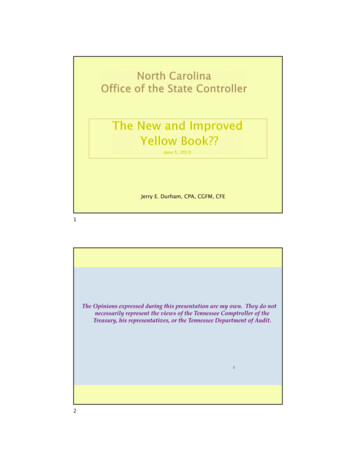
Transcription
Jerry E. Durham, CPA, CGFM, CFE122
3 Why is the Yellow Book called the Yellow Book? As one story goes, the original title of the YellowBook was supposed to be “The Golden Rule ofGovernment Auditing” and the cover was supposedto be Gold. You will notice that this is not the title and the coveris not Gold. Again, as the story goes, the printingoffice did not have Gold cover paper, so they usedYellow. And the rest, as they say, is History. So, since its first publishing date, it has been arather bold Yellow Book.4
A slightly different story was told by Marcia Buchanan who wasresponsible for the Yellow Book development over a period of 22years.“Well, the Yellow Book is Generally Accepted Government AuditingStandards. It is a publication that GAO's been producing since1972. And the way the first Yellow Book happened was, the StateAudit Community came to the Congress and said”"Gee, we need a set of standards that increase accountability andtransparency for government money." The Congress turned toGAO and asked us to put together a set of auditing standards.Interesting enough, the Government Auditing Standards, knownas the Yellow Book, is named the Yellow Book because the groupthat put it together in 1972 thought that it oughtta have a goldcover on it, called it the "Golden Rules of Auditing."And the Comptroller General at the time, Elmer Staats, thoughtthat was very presumptuous. And so it became, then, the YellowBook. It got close to the gold but not completely. So the YellowBook it became. And the only thing that will never change on theYellow Book is the color of the cover.55 Why was the Yellow Book first published? The Yellow Book was published for use by the FederalGovernment by the GAO. The GAO is the Auditor for the Federal Government, and theYellow Book was designed for use by Federal Auditors. It was intended as set of Federal Audit “Standards” forFederal Government Auditors. State and Local governmentscould adopt the standard by law or other methods. Although, the Yellow Book is a GAO document, it wascreated at the request of state and local governments andtheir professional associations including AGA.6
But something happened in 1984 that had asignificant influence on the adoption of the YellowBook by state and local governments. What wasit? GASB was established in 1984 The Single Audit Act was passed in 1984 GAO required all state and local governments to use theYellow Book AGA established a best practice document encouragingall state and local governments to use the Yellow Book7 How many states have adopted the Yellow Book? The Yellow Book has been adopted by all but 2 or 3States. This usually means for local governments aswell. Tennessee uses the Yellow Book standards for audit forFinancial, Attestation, and Performance Audits. What about North Carolina?8
OMB’s Uniform Guidance?UG requires a YellowBook audit and adds tothe standards requiredby the Yellow Book.The Yellow Book (GAO)incorporates the SASs by referenceand adds to those standards.The ASB (AICPA) establishes the SASs andSSAEs. SAS 117 Specifically deals withCompliance (UG) Audits99 When was the first Yellow Book published? 101972197419811984
When was the first Yellow Book published? 1972 – Standards for Audit of Governmental Organizations,Programs, Activities and Functions 1974 1981 1988 – Government Auditing Standards 1994 1999 – Two Amendments, not full revision 2003 2007 2011 20181154 Pages12
13 Who uses the Yellow Book? Federal Inspectors General Auditors must use the YellowBook Auditors of most Federal Agencies must use the YellowBook Auditors of Federal Programs under OMB’s UniformGuidance must use the Yellow Book Internal Auditors for Federal Agencies generally use theYellow Book. What about the rest of us?14
“Yellow Book” orGASGenerallyAcceptedGovernmentAuditing Standards(“GAGAS”)7 x 10 size1515 “Yellow ndards(“GAGAS”)Now 8 ½ by 11size.1616
Exposure Draft issued April 5, 2017 First proposed changes since 2011 Public comments were due to GAO no later than July6, 2017 Why Issued? Represents a modernized version that takes into accountdevelopments in the accounting and auditing professions Intended to reinforce principles of transparency and provide aframework for high quality government audits GAO received 95 comment letters with over 1,700individual comments on the exposure draft.1717 Final Version was issued July 17, 2018 Effective Date: Financial Audits, AttestationEngagements, and Reviews of Financial Statements Periods ending on or after June 30, 2020. Calendar Year 2020 Fiscal Years Ending on June 30, 2021 Effective Date: Performance Audits beginning on orafter July 1, 2019 Early implementation is not permitted.1818
http://www.gao.gov/yellowbook/overview19 Just a personal thought from me as we begin: There are more and more standards that must befollowed by auditors. Sometimes the overload creates ethical dilemmas forauditors. I don’t have time. I will be over my time budget. We’ve always audited this way and its been OK up untilnow. Who will notice. Our quality control is not that greatanyway. It is unlikely peer review will pick this audit. If I write this finding, I will probably lose this client. Independence does not apply to my situation.20
What I consider asimportant changes:themost1. New format and organization of GAGAS2. ancialstatements (Chapter 3)3. DocumentingSKE(Chapter3)(application guidance)4. Changes to Waste and Abuse (definitionof waste, and reporting of waste andabuse) (Chapters 6, 7, 8, and 9)5. Quality Control Expanded Requirements(Chapter 5)2121 What I consider as the most importantchanges:6. Peer review requirements (Chapter 5)7. Internal control: financial audits, examinationengagements, and performance audits. Shouldconsider internal control when determining thecause of any finding. (2011 YB referred toInternal Controls 142 times, the 2018 YB refersto Internal Controls 202 times) (Chapters 8 and9)8. Internal Control documentation and reporting forPerformance Audit (Chapters 8 and 9)2222
Overall Changes From 235 to 224, but larger format Chapters – From 7 to 9Chapters – Reorganized and RealignedAll Chapters – Revised FormatSupplemental Appendix Guidance –Incorporated into ChaptersRemovedor23Old Yellow Book1.2.Government Auditing: FoundationNew Yellow Book1.Foundation and Principles for the Useand Ethical Principlesand Application of GovernmentStandards for Use and Application ofAuditing StandardsGAGAS3.General Standards4.Standards for Financial Audits2.General Requirements for Complyingwith Government Auditing Standards3.Ethics, Independence, andProfessional Judgment4.Competence and ContinuingProfessional Education24
New Yellow BookOld Yellow Book5.6.7.Standards for Attestation5.Quality Control and Peer ReviewEngagements6.Standards for Financial AuditsField Work Standards for7.Standards for AttestationPerformance AuditsEngagements and Reviews ofReporting Standards forFinancial StatementsPerformance Audits8.Fieldwork Standards forPerformance Audits9.Reporting Standards forPerformance Audits25 Application Guidance: 2.05 Auditors should have an understanding of the entire textof applicable chapters of GAGAS, including applicationguidance, and any amendments that GAO issued, tounderstand the intent of the requirements and to apply therequirements properly. 2.07 GAGAS contains requirements together with relatedexplanatory material in the form of application guidance. Notevery paragraph of GAGAS carries a requirement. Rather,GAGAS identifies the requirements through use of specificlanguage. GAGAS also contains introductory material thatprovides context relevant to a proper understanding of aGAGAS chapter or section. Having an understanding of theentire text of applicable GAGAS includes an understanding ofany financial audit, attestation, and reviews of financialstatement standards incorporated by reference.26
Application Guidance (Cont’d): 2.09 The application guidance provides further explanation ofthe requirements and guidance for applying them. In particular,it may explain more precisely what a requirement means or isintended to address or include examples of procedures that maybe appropriate in the circumstances. Although such guidancedoes not in itself impose a requirement, it is relevant to theproper application of the requirements. “May,” “might,” and“could” are used to describe these actions and procedures. Theapplication guidance may also provide background informationon matters addressed in GAGAS.27 28The “Yellow Book” GAGAS GAGAS is required when auditsof states, local governments,tribal nations and not-forprofits meet certain criteria inthe Uniform Guidance (Title 2,Code of Federal Regulations,Part 200) (Uniform Guidance orUG): Also required by State Law,Regulation, OutsideGrantors, Lenders etc. Applying for federal grantsmay require GAGAS.GAGAS Generally AcceptedGovernment Auditing Standards: Overlay of GenerallyAccepted Auditing Standards(GAAS) issued by the AuditingStandards Board.GAGAS contains the frameworkfor ensuring that auditorspossess competence, integrity,objectivity, and independence inplanning, conducting, andreporting on their work.
The 2018 Yellow Book has 36 references to InternalAudit Certain entities employ auditors to work for entitymanagement. These auditors may be subject toadministrative direction from persons involved in the entitymanagement process. Such audit organizations are internalaudit functions and are encouraged to use the Institute ofInternal Auditors’ International Standards for theProfessional Practice of Internal Auditing, in conjunctionwith GAGAS. (3.57) Most of those references relate to Independence in Chapter3 and Competence in Chapter 4. An internal audit organization that reports internally tomanagement and those charged with governance shouldprovide a copy of its peer review report to those chargedwith governance. (5.77) External Auditors using the work of Internal Auditor.(Chapter 8) Report Distribution in Chapter 9. (9.57)29 Chapter 1 – Government Auditing: Foundation andPrinciples for the Use and Application of GenerallyAccepted Government Auditing Standards Examples of types of GAGAS users are addressed. (para. 1.12) Integrated audit is added to the types of financial audits. (para.1.17.b) Descriptions of attestation engagements, reviews of financialstatements, and performance audits are expanded. (paras. 1.18through 1.26) Definitions of common terms used in GAGAS are expanded.Definitions for terms such as engaging party, audited entity,responsible party, and specialist are added. (para. 1.27) (Also aGlossary in the Back)30
Chapter 2 - General Requirements forComplying with Government AuditingStandards Guidance is expanded to explain that for financialaudits, attestation engagements, and reviews offinancial statements, GAGAS does not incorporatethe American Institute of Certified PublicAccountants Code of Conduct by reference butrecognizesthatcertaincertifiedpublicaccountants (CPA) may use or may be required touse the code in conjunction with GAGAS. (para.2.14)31 New format, similar to Codification of GAAS Requirements separated from application guidance and otherexplanations Requirements are in boxesThinking Insidethe BoxTypical section ofrequirements andapplication guidance32
Unconditional requirements – ‘must’ – complywhere relevantPresumptively mandatory requirements –‘should’ – if the auditor departments fromrequirements, must document whyApplication guidance – ‘may’, ‘might’, ‘could’– further explanations provided33 Yellow Book:Preparing financial statements in theirentirety is always a significant threat Documentation and evaluation ofsignificance of threats for preparingaccounting records and financial statementsis required Documentation of skills, knowledge andexperienceSimilarities, but not quite aligned – Threats and safeguards approach used byboth - but Yellow Book requires it on allcircumstances that may result in threats toindependence Nonaudit services are permitted by AICPAunless there are significant threats Nonaudit services are also allowed by YellowBook but may require safeguards 34Note: Impairments do notalways bans. Safeguardsmay be available
Auditors required to determine that the audited entity hasdesignated an individual who possesses suitable skills,knowledge or experience and that understands the services tobe provided sufficiently to oversee them before auditorsagree to perform nonaudit services and Ske should bedocumented at the beginning the audit. (3.73) Management is not required to possess the expertise toperform or reperform servicesIf SKE is not present, independence impaired and nosafeguards can overcome a lack of SKE35 3.79 (application guidance) “is not required to possess the expertiseto perform or re-perform the services. However, indicators ofmanagement’s ability to effectively oversee the nonaudit serviceinclude management’s ability to determine the reasonableness of theresults of the nonaudit services provided, and to recognize amaterial error, omission, or misstatement in the results of thenonaudit services provided.” Think “Examples” as another word for “indicators.” “Other things (examples) could be used” to demonstrate management’sSKE (Skills, Knowledge, or Experience) What GAO is trying to achieve is “Not just blind acceptance”. This is implementation guidance. The word “indicator” is used in other places in the standard (4.07and following).3636
Nonaudit services performed by auditors related tofinancial statements and accounting records either:ImpairIndependenceAre SignificantThreatsAre ThreatsNo change from 2011 Yellow Book (para. 3.87)The auditor prepares financial statementsin their entirety (para. 3.88).ORThe auditor determines that a servicerelated to preparing financial statementsor accounting records is a significantthreat (para. 3.93). Document the threatsand safeguards appliedto eliminate and reducethreats to an acceptablelevel (para. 3.33).ORDecline to perform theservice (para. 3.88).Evaluate threat and document evaluation (para. 3.90).Typing, formatting, printing, binding: not likely significant (para.3.95)3737 38Any other services related to preparing accounting records(e.g. payroll) and financial statements create a threat Auditors required to evaluate if it is significant anddocumentCould occur when auditor Records transactions for which management hasdetermined or approved the appropriate accountclassification or posting the coded transactions to the GL Prepares certain line items or sections of the financialsbased on trial balance Posts entries after management approval Prepares accounting reconciliations that identifyreconciling items for management to evaluate and approve
Binding, typing,formatting usually notsignificant to be anissue. But preppingwithout safeguards is.Providing advice,responding to questions,training does not impairindependence.Preparing AuditAdjustments as part ofthe audit is not anonaudit service.39Preparation team is different from audit team (evendifferent audit management).Having a second auditor not associated with theengagement review the preparation work.Engaging another audit organization to evaluatethe results of the preparation.Engaging another audit organization to prep thefinancial statements again to see if same results –auditor can then take responsibility.40
Par. 3.72: These activities are not going to create threats, ifperformed by a State audit organization providing: Assistance and technical expertise to Legislative bodies Assistance in reviewing budgets Audit, investigative, oversight that does not involve aGAGAS engagement, including Fraud investigations Periodic follow ups to engagements and reportsOtherwise, follow statute or constitution and then theframework41Includes all threats– not just financialstatementpreparation. Self –Interest Self-Review Bias Familiarity Undue Influence Mgmt.Participation Structural ThreatSee previoustree42
Good news! – 4 hour transition requirement as proposed notin final version!Good idea to obtain CPE specifically on GAGAS this year andnext due to the revisions in the standards Will assist you in maintaining competence necessary toconduct GAGAS audits (4.19)Audit organization still has responsibility for Assigning competent auditors Ensuring the collective competence of the team beforebeginning the engagement Keeping documentation of CPE 43 44Certain exceptions to CPE Illness, sabbaticals, maternity / paternity and other leave, militaryservice Non-supervisory auditors (low-level roles) that charge less than40 hours to audits, exempted from CPE Specialists must be qualified and competent in their area ofexpertise – not required to take full GAGAS CPE External specialists not subject to GAGAS CPE Internal specialists who are not involved in the planning,directing, performing the audit – not required to take GAGASCPE – but areas of specialization qualifies under 24 hourprovisions Documentation still required of allKey requirements for all others – 20 hours minimum each year
CPEHoursSubject Matter Categories of CPE24HoursSubject matter directly related to government, governmentauditing, or specific, unique operating environment of entity56HoursSubject matter that ‘enhances professional expertise toconduct engagements’45GAGASGAAP (FASAB,GASB, FASB)Auditstandards,guides, (IT,forensics)Statutory /regulatoryPerformanceauditing topicsAICPA AuditStandardsGreen BookIT auditingtopicsRelevantsubject matterstoengagementsEthics andindependenceAICPAAttestationStandardsCOSOFraud topicsGovernmentoperations,finance etc.Public / privatepartnershipsPCAOBProgram auditrequirementsStatutoryrequirements –specific ncewith laws andregulationsFraud, waste,abuse,improperpayments46
All 24 hour subjectsGeneral ethics and independenceAccounting, asset management, budgeting, cashmanagement, data analysis, procurement and similarCommunications – oral and writtenManaging time and resourcesLeadershipSoftware applications in engagementsInformation technologyEconomicsHuman capitalSocial / political sciences47 48Internal trainingEducational and development – conferences,meetings etc.Training by audit organizations, foundations,associationsInternet / e-learningAudio conferencesCollege / university (credit and noncredit)Correspondence courses – self studyPublic speaking, panelists, discussion leadersPreparing review coursesPublishing articles / books
Several Changes that relate to quality control. (Chapter 5)that will likely require some changes to your firm’s qualitycontrol polices and procedures. Standard is modified to require that audit organizationsat least annually obtain written affirmation of compliancewith policies and procedures on independence from allaudit organization personnel required to be independent.(para. 5.09) The policies and procedures should require thatexperienced engagement team members review the workof less experienced engagement team members.4949 Several Changes that relate to quality control. (Chapter 5)that will likely require some changes to your firm’s qualitycontrol polices and procedures. The audit organization should assign responsibility foreach engagement to an engagement team partner ordirector with authority to assume that responsibility.(5.37) The audit organization should establish policies andprocedures requiring the audit organization tocommunicate the identity and role of the engagementpartner or director to management and those chargedwith governance of the audited entity. (5.37)5050
Several Changes that relate to quality control. (Chapter 5)that will likely require some changes to your firm’squality control polices and procedures. The audit organization should establish policies andprocedures requiring the audit organization to clearlydefine the responsibilities of the engagement partneror director and communicate them to that individual.(5.37)5151 Standard is modified to require that auditorganizations affiliated with a ization’s peer review requirements andadditional GAGAS peer review requirements.(para. 5.60-62) American Institute of Certified Public Accountants Council of the Inspectors General on Integrity andEfficiency Association of Local Government Auditors International Organization of Supreme Audit Institutions National State Auditors Association52
Definitions and Differences: Fraud, Waste, and AbuseWhy Fraud, Waste, and Abuse in Government isDifferent than Fraud, Waste, and Abuse ElsewhereThe Fraud, Waste, and Abuse Requirements in the New2018 Yellow Book53An Illustrative Case Study54
Jeff Neely was GSA regional commissioner andoversaw a lavish 822,751 training conference in LasVegas in 2010 for approximately 300 GSA employees– 136,504 for pre‐conference travel, catering,vendors, and other hotel costs– 686,247 for conference travel, catering, andvendorsSource: GSA OIG Report, 2 April 201255 Expenditures included:– 136,504 on 8 pre‐conference scouting trips, including 6 to the LasVegas hotel (5 to 31 GSA employees per trip)– 146,000 for catered food– 44 per person daily breakfasts– 95 per person closing dinner including 525 in bartender servicefees– 5,600 for semi‐private catered in‐room parties– 6,325 on commemorative Recovery Act coins housed in velvetboxes– 8,130 for attendee “yearbooks”– 75,000 on a bicycle‐building training exercise.Source: GSA OIG Report, 2 April 201256
Source: GSA OIG Report, 2 April 201257#1 The Scandal Over GSA’sSpending of Taxpayer 71001/#sp showclips#2 The Senate weighs in onGSA’s Spending of TaxpayerMoney Videohttps://www.bing.com/videos/search?q gsa scandal fox business video&view detail&mid FAE8F3A207AEA478F23EFAE8F3A207AEA478F23E&FORM VIRE58
59Involves obtaining something of value through willfulmisrepresentation.Whether an act is, in fact, fraud is determined throughthe judicial or other adjudicative system and is beyondauditors’ professional responsibility.[2018 Yellow Book, page 214]60
The act of using or expending resources carelessly,extravagantly, or to no purpose.Waste can include activities that do not include abuseand does not necessarily involve a violation of law.[2018 Yellow Book, pages 220‐221]61a.Making travel choices that are contrary to existingtravel policies or are unnecessarily extravagant orexpensive.b.Making procurement or vendor selections that arecontrary to existing policies or are unnecessarilyextravagant or expensive.[GAGAS 6.22]62
a.Making travel choices that are contrary to existingtravel policies or are unnecessarily extravagant orexpensive.b.Making procurement or vendor selections that arecontrary to existing policies or are unnecessarilyextravagant or expensive.Interestingly, these were cited asexamples of abuse in the 2011 Yellow[GAGAS 6.22]Book.63Behavior that is deficient or improper when comparedwith behavior that a prudent person would considerreasonable and necessary business practice given thefacts and circumstances, but excludes fraud andnoncompliance with provisions of laws, regulations,contracts, and grant agreements.[2018 Yellow Book, page 211]64
a.b.c.Creating unneeded overtime.Requesting staff to perform personal errands orwork tasks for a supervisor or manager.Misusing the official’s position for personal gain These were cited as examples of abusein the 2011 Yellow Book.[GAGAS 6.24]6566
Neely was indicted in September 2014 on five countsof falsely claiming reimbursement for pleasure tripsor airplane tickets that he did not use Neely pleaded guilty to one count of fraud againstthe government in April 2015 Neely was sentenced in June 2015 to 3 months inprison, 3 months under home confinement, and 3years of probation Neely was ordered to pay 8,000 in restitution, a 2,000 fine, and a 100 special assessment penaltySource:67 The 822,000 spent on the training conference in LasVegas was approximately 0.000024% of the 3,456,000,000,000 federal budget for 201068
Key Player6970GSA PositionOutcomeMartha JohnsonAdministratorResignedJeff NeelyRegional CommissionerConvicted; sentencedRobert PeckPublic Buildings ServiceCommissionerFired; working in private sectorPaul ProutyRegional CommissionerFired, but reinstated by MSPBJim WellerRegional CommissionerFired, but reinstated by MSPBRobin GrafRegional CommissionerRetiredStephen LeedsSenior CounselFired; working in private sector
“Improper payments” occur when: federal funds go to the wrong recipient, the recipient receives the incorrect amount offunds (either an underpayment or overpayment), documentation is not available to support apayment, or, the recipient uses federal funds in an impropermanner.Each component couldinclude fraud, waste, orabuse71 72Blurred lines between fraud, waste, abuse, andmismanagement“Materiality” has a different meaning to taxpayersand taxpayers don’t really differentiate betweenfraud, waste, abuse, and mismanagementVirtually everything is in the public domainGovernments have strong and visible audit andinvestigation capabilities (GAO, IGs, state auditors,etc.)VERY LARGE amounts of money are involvedProgram objectives are often in conflict withstrong/strict accountability
Example The objective of disaster relieve programs is toalleviate the impact of disasters quickly Requiring checks, balances, thoroughdocumentation (i.e., prevention controls) wouldinterfere with achieving that objective Detective controls are more appropriate, butchasing fraudulent benefits paid is very difficultand expensive73 Governments do not always have the bestaccounting systems and capabilitiesGovernment accounting principles, laws, rules, andregulations create opportunities for fraudPower corrupts WHAT ELSE ? 74
The Fraud, Waste, and AbuseRequirements in the New 2018Yellow Book75Financial Audits: The auditor has a responsibility to plan and perform the auditto obtain reasonable assurance about whether the financialstatements are free of material misstatement, whether causedby error or fraud. [SAS 99; GAGAS 6.01] Auditors should include in their report on internal control orcompliance the relevant information about noncomplianceand fraud when auditors, based on sufficient, appropriateevidence, identify or suspect fraud that is material, eitherquantitatively or qualitatively, to the financial statements orother financial data significant to the audit objectives. [GAGAS6.41]76
Financial Audits: Auditors should communicate in writing to auditedentity officials when the auditor has obtainedevidence of identified or suspected instances offraud that have an effect on the financialstatements or other financial data significant to theaudit objectives that are less than material butwarrant the attention of those charged withgovernance. [GAGAS 6.44]77Performance Audits: Auditors should assess the risk of fraud occurring that is significantwithin the context of the audit objectives.Audit team members should discuss among the team fraud risks,including factors such as individuals’ incentives or pressures tocommit fraud, the opportunity for fraud to occur, andrationalizations or attitudes that could increase the risk of fraud.Auditors should gather and assess information to identify the risk offraud that is significant within the scope of the audit objectives orthat could affect the findings and conclusions. [GAGAS 8.71]I.e., the “brainstorming”requirement in SAS 9978
Performance Audits: Assessing the risk of fraud is an ongoing processthroughout the audit. When information comesto the auditors’ attention indicating that fraud,significant within the context of the auditobjectives, may have occurred, auditors shouldextend the audit steps and procedures, asnecessary, to (1) determine whether fraud haslikely occurred and (2) if so, determine its effecton the audit findings. [GAGAS 8.72]79Performance Audits: 80Auditors should report a matter as a finding when theyconclude, based on sufficient, appropriate evidence, thatfraud either has occurred or is likely to have occurred thatis significant to the audit objectives. [GAGAS 9.40]Auditors should communicate findings in writing toaudited entity officials when the auditors detect instancesof fraud that are not significant within the context of theaudit objectives but warrant the attention of thosecharged with governance. [GAGAS 9.41]
Financial Audits Because the determination of waste and abuse issubjective, auditors are not required to perform specificprocedures to detect waste or abuse in financial audits. However, auditors may consider whether and how tocommunicate such matters if they become aware ofthem. Auditors may also discover that waste or abuse areindicative of fraud or noncompliance with provisions oflaws, regulations, contracts, and grant agreements.[GAGAS 6.20]81Performance Audits Because the determination of waste and abuse issubjective, auditors are not required to perform specificprocedures to detect waste or abuse in performanceaudits. However, auditors may consider whether and how tocommunicate such matters if they become aware of them. Auditors may also discover that waste or abuse areindicative of fraud or noncompliance with provisions oflaws, regulations, contracts, and grant agreements.[GAGAS 8.119]82
2011 GAGAS2018 GAGASThe word “fraud” appears117 times95 timesThe word “waste” appears2 times29 timesThe word “abuse” appears108 times29 times241232Total pages83 84Fraud is a legal determination “beyond auditors’prof
Book it became. And the only thing that will never change on the Yellow Book is the color of the cover. 5 Why was the Yellow Book first published? The Yellow Book was published for use by the Federal Government by the GAO. The GAO is the Auditor for the Federal Government, and the Yellow Book was designed for use by Federal Auditors.
